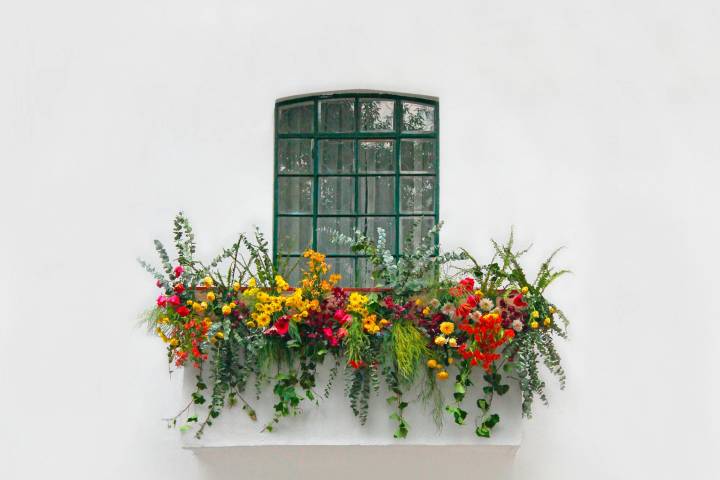
Moving to the city means trading wide-open spaces for the vibrant rhythm of urban life. But, a lack of square footage need not deter you from nurturing green sanctuaries.
For those carving out a personal oasis amid concrete landscapes, vertical gardens stand as monuments to ingenuity and nature’s adaptability. That means city dwellers can reimagine their balconies and modest backdrops into lush, ascending Edens.
This exploration delves into how shelving units, crisscross panels, and diverse container types transform limited expanses into thriving vertical landscapes.
Selecting the Right Skeleton
The first step when integrating a vertical garden in your small urban space is choosing the right support structure – the silent hero that holds your verdant vision together. Start by selecting shelving units strong enough to bear the weight of soil and water yet slim enough to fit snug corners or tight wall spaces. Crisscross panels are equally important, offering a grid upon which climbing plants can ascend.
Choosing diverse container types is another critical step. From hanging pots to modular planters, each plays a unique role in maximizing growth areas while accommodating different species’ needs. Materials matter here; select weather-resistant options like treated wood or durable plastics that stand up to the elements.
For city inhabitants, these gardens represent more than just decor. They’re a commitment to bringing life and vitality into spaces where soil and skies seem far away. So, let’s gather our tools and build sturdy foundations for our green havens in the sky.
Embracing Technology in Design
Before a single seed is sown or a planter hung, the smart urban gardener turns to technology.
A landscape design software solution becomes an invaluable ally, allowing you to visualize your vertical garden in its intended space before committing to the physical build.
These digital tools let you experiment with layout variations and plant combinations, offering a glimpse of seasonal changes and growth progressions. They also help identify which areas receive ample sunlight and which may need additional support or irrigation solutions.
Adopting this tech-forward approach mitigates trial-and-error frustrations. Plus, it equips you with a solid plan that not only looks good on screen but is wholly achievable in real life – bringing your personalized touch of nature into the urban jungle with confidence and foresight.
Cultivating Your Selection
Once the framework stands ready and the design is set, the focus turns to plant selection – a process where preferences meet practicality.
Choosing flora that not only flourishes in a vertical setting but also thrives in your specific urban climate is paramount. Succulents may grace many a Pinterest page, but herbs or compact vegetables could be what your city balcony craves.
Meanwhile, ornamental plants can add splashes of color and texture against the brick-and-mortar backdrop. Consider perennials for longevity or annuals to change with the seasons. And remember pollinators; even in the city, small flowers can attract bees and butterflies, vital for maintaining urban ecosystems.
Sustaining the Heights
Creating your vertical garden is one thing, and sustaining it is another.
Maintenance strategies become as integral as the plants themselves. Irrigation systems, whether DIY drip lines or sophisticated, automated setups, ensure consistent watering without daily toil. Nutrient management, too, must adapt to this high-rise horticulture—think liquid fertilizers and compost teas that can navigate narrow containers.
And let’s not overlook the importance of regular pruning and plant rotation—tactics that foster healthy growth and prevent any one species from overshadowing its neighbors.
Even in the most confined urban spaces, a well-tended vertical garden can prosper, offering a dynamic slice of nature that evolves with care and attention—a living tapestry woven into the fabric of city life.
Community and Well-being
Beyond aesthetics and personal satisfaction, these skyward gardens have a ripple effect. They’re catalysts for community interaction and environmental awareness in the bustling cityscape.
Incorporating vertical gardens into your urban lifestyle allows you to contribute to improved air quality and a reduction in the heat island effect—a small but significant victory for sustainability. Such initiatives are not uncommon to spark conversations with neighbors, fostering a sense of community as people share tips, clippings, or simply admire the greenery.
Navigating Challenges and Change
While vertical gardens offer myriad benefits, they also present unique challenges. Awareness and adaptability become essential tools in any urban gardener’s arsenal.
Weather variances—intense sun, wind tunnels between buildings, unexpected frost—can test the resilience of your garden. Choosing hardy plants acclimatized to your region can mitigate some risks, but monitoring and protective measures like shades or windbreaks may be necessary.
Moreover, city ordinances and building regulations must be considered; not every green dream is feasible within the constraints imposed by property management or local laws. Engaging with these entities early on ensures your garden complies with regulations while still reaching for the skies.
Adapting to these challenges not only strengthens your horticultural endeavor but also exemplifies the tenacity required to cultivate beauty and sustainability in an ever-changing urban terrain.
Final Thoughts
Your journey into vertical gardening is more than an exercise in space maximization—it’s a transformative endeavor that redefines the urban living experience. Each shelf, panel, and plant becomes part of a greater narrative that intertwines nature with modernity, creating pockets of tranquility in a fast-paced world.
So embrace this intersection of innovation and simplicity where green thumbs guide urban renewal. Because within these vertical oases lie the seeds of personal well-being and collective ecological progress—both reaching ever upward toward brighter, greener futures.
We hope you found this blog post on Maximizing Small Urban Spaces: Integrating Vertical Gardens in Your City Move, useful. Be sure to check out our post on Benefits of Portable Gardens For City Dwellers for more great tips!
Have Experience in the Moving Industry? Want an Additional Income Stream? Work With All Around Moving!
Work With Us program gives the opportunity to experienced moving consultants to run their own Moving Consultant business from anywhere in the United States. Click here to learn more.





